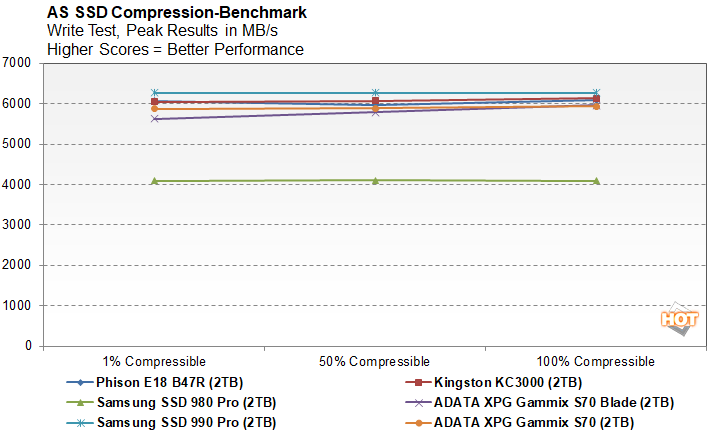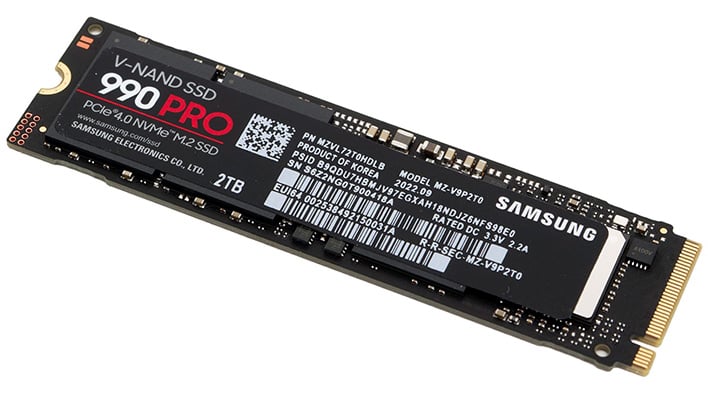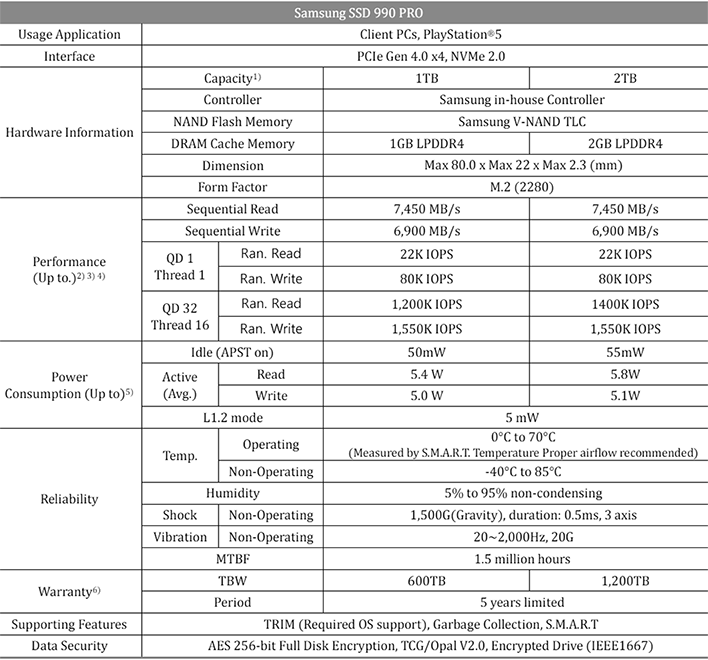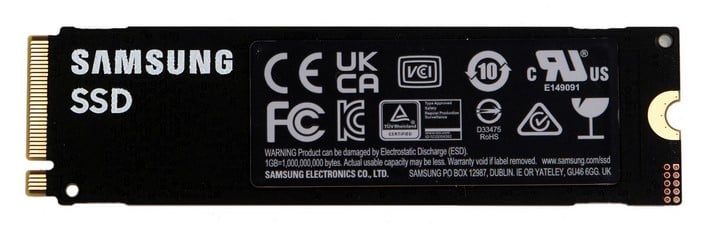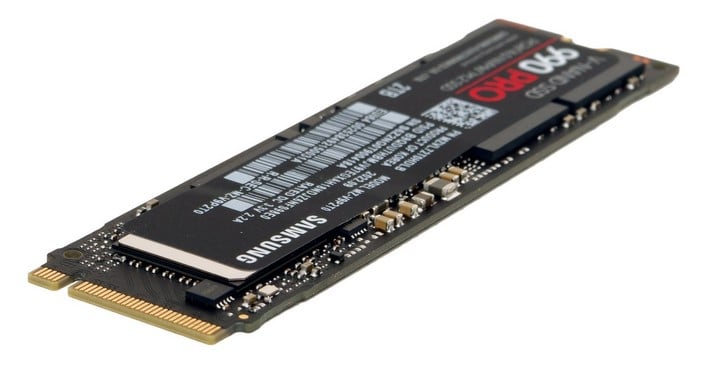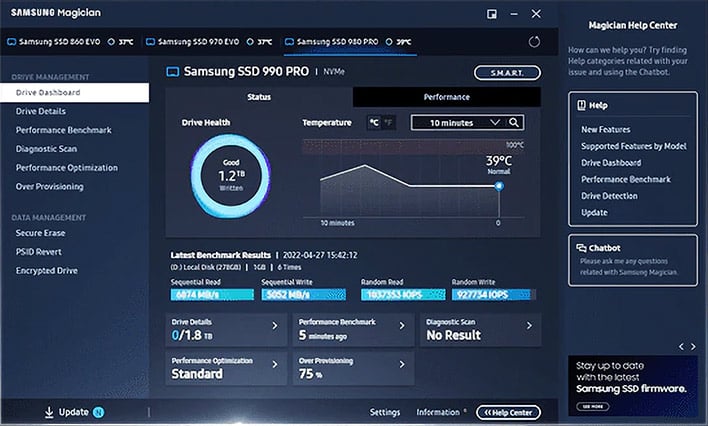Samsung SSD 990 Pro Review: Super-Fast Storage For Gamers
Samsung SSD 990 Pro: The Latest V-NAND And A New 8nm Controller Boost Performance
| Samsung SSD 990 Pro: Starting At $169 A new, more efficient controller and fresh V-NAND boost Samsung SSD 990 Pro series performance to over 7.4GB/s, while consuming less power. It's a win-win.
|
|||

|

|
||
Samsung was relatively early to the PCI Express Gen 4 NVMe SSD party with its 980 Pro series of drives, which we reviewed way back in September 2020. While that drive was speedy in its day, the Samsung SSD 980 Pro was quickly eclipsed by faster PCIe Gen 4 drives based on Phison or Innogrit controllers, like the Kingston KC3000 (Phison) or Adata XPG S70 (Innogrit), among others. In the interim, Samsung released handful of more mainstream, affordable SSDs, but in August the company announced its latest enthusiast-class solid state drives, the Samsung SSD 990 Pro.
The Samsung SSD 990 Pro remains tied to the PCIe Gen 4 interface, but this drive features an updated controller and Samsung’s latest V-NAND flash memory to boost performance significantly. You can take a look at the Samsung SSD 990 Pro’s main features and specifications here, but we’ll dig in much further in the pages ahead...
Samsung SSD 990 Pro Specifications And Features
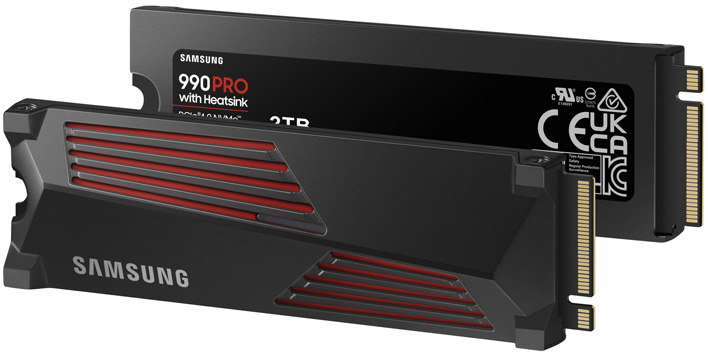
Samsung SSD 990 Pro Drives With Heatsinks Are Coming Soon
Samsung SSD 990 Pro Gen 4 drives will initially be offered in two capacities—1TB and 2TB—and in two flavors, with and without an integrated heatsink. A 4TB model is also planned, but won’t be arriving until next year. We will be featuring the 2TB model without heatsink in this evaluation.
All of the drives in the Samsung SSD 990 Pro series use the common M.2 (2280) ‘gumstick’ form factor, but the performance between the different models varies slightly depending on their capacity. Both capacities will offer similar sequential transfers, of 7.45GB/s (read) and 6.9GB/s (writes), and similar IOPs at QD1 (Queue Depth), but at QD32 the 1TB model will have somewhat lower (but still good) random read performance.
The Samsung SSD 990 Pro drives’ max IOPS ratings vary depending on queue depth, but peak at right around 1,200K – 1,550K at QD32. The drives’ endurance ratings also vary based on capacity, as you would expect, with the 1TB drive landing at the 600TBW mark and the bigger 2TB drive hitting 1200TBW, which is similar to the 980 Pros, but actually lower than the older 970 Pro series.
The Samsung SSD 990 Pro series features Samsung’s latest V-NAND flash memory. To be specific, the drives are equipped with, 1xx-layer (up to 144 layer) TLC 3-bit per cell V-NAND flash with 3D charge trap flash (CTF) cells. Samsung’s latest V-NAND offers lower latency for reads and writes, at similar or lower power than its previous-generation V-NAND.
The drives are also outfitted with a new controller. In addition to the native PCI Express 4.0 interface, the controller is manufactured on Samsung’s leading-edge 8nm process and reportedly offers a nearly 50% improvement in performance-per-watt. According to Samsung, the 980 Pro offers sequential Read / Write performance of 1,129MB / 877MB per watt, whereas the new 990 Pro can hit a sequential Read / Write of 1,380MB / 1,319MB per watt based on internal testing of the 1TB model.
The Samsung SSD 990 Pro’s controller supports all of the features you’d expect from a modern SSD, like TRIM, garbage collection, S.M.A.R.T., etc., in addition to various encryption technologies. Depending on the capacity, the first wave of drives also feature 1GB or 2GB of discrete LPDDR4 DRAM cache, with the 2TB drive packing the maximum config. The 4TB drive that's coming later will have a 4GB LPDDR4 DRAM cache.
Like the last couple generations of Samsung Pro SSDs, the controller has a nickel coating that helps to dissipate heat and the underside of the drives has a thin plate hidden underneath the decal to aid in cooling. The drives also support Samsung's Dynamic Thermal Guard, which helps manage power and thermals based on the drives' workload to minimize any potential throttling.
Samsung SSD 990 Pro drives also feature TurboWrite technology, similar to Samsung EVO-branded drives. TurboWrite uses a portion of the drive's V-NAND as an SLC write buffer, which results in improved write performance, as long as the buffer isn’t exhausted. As was the case with previous-gen drives, the TurboWrite buffer dynamically adjusts in size based on the workload.
TurboWrite will also allow the Samsung SSD 990 Pro drives to perform well in the vast majority of consumer-class workloads, because writes are fastest when the SLC buffer is being utilized. Once the buffer is exhausted, write performance can taper off, but on the 2TB drive we tested, the SLC cache is flushed fast enough to maintain strong write performance across the entire capacity of the drive.
Samsung warranties the SSD 990 Pro series drives for 5 years, which is in-line with previous-gen offerings, and the drives are also supported by Samsung’s Magician SSD management utility. Anecdotally, in all of the years we have been evaluating Samsung SSDs, we have yet to have one fail. Every one of the Samsung drives we have on hand, including much older SATA-based solutions, are still functional, for what it's worth.
Samsung SSD 990 Pro PCIe Gen 4 SSD Benchmarks
Under each test condition, the SSDs showcased here were installed as secondary volumes in our testbed, with a separate drive used for the OS and benchmark installations. Our testbed's motherboard was updated with the latest BIOS available at the time of publication and Windows 11 was fully updated. Windows firewall, automatic updates, and screen savers were all disabled before testing and Focus Assist was enabled to prevent any interruptions.
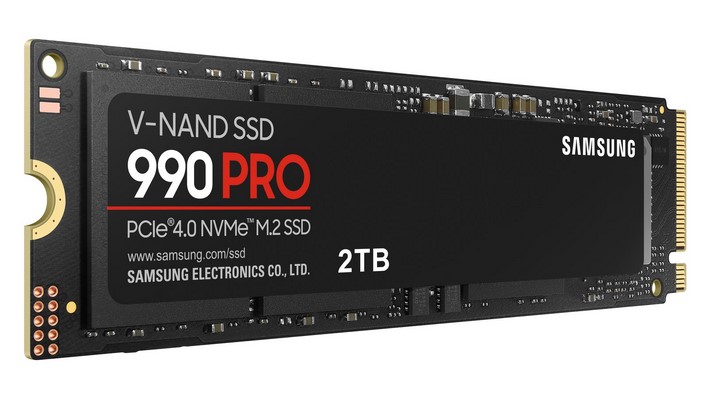
HotHardware's Test System:
| Processor: AMD Ryzen 9 5950X Motherboard: Gigabyte Aorus X570 Pro Wi-Fi (X570 Chipset) Video Card: GeForce RTX 3080 Memory: 32GB G.SKILL DDR4-3200 Storage: Samsung SSD 980 Pro (OS Drive) ADATA XPG GAMMIX S70 Blade (2TB) ADATA XPG GAMMIX S70 (2TB) Phison E18 B47R (2TB) Samsung SSD 980 Pro (2TB) Kingston KC3000 (2TB) Samsung SSD 990 Pro (2TB) |
OS: Windows 11 Pro x64 Chipset Drivers: AMD v3.10.22.706 Benchmarks: IOMeter 1.1 HD Tune v5.75 ATTO v4.01.02f AS SSD SiSoftware SANDRA CrystalDiskMark v8.0.4 x64 Final Fantasy XIV: Endwalker PCMark 10 Quick Storage Bench 3DMark Storage Tests |
IOMeter Benchmarks
IOMeter is a well-respected industry standard benchmark. However, despite our results with IOMeter scaling as expected, it is debatable as to whether or not certain access patterns actually provide a valid example of real-world performance. The access patterns we tested may not reflect your particular workloads, for example. That said, we do think IOMeter is a reliable gauge for relative throughput, latency, and bandwidth with a given storage solution. In addition, there are certain highly-strenuous workloads you can place on a drive with IOMeter, that you can't with most other storage benchmark tools.In the following tables, we're showing two sets of access patterns; a custom Workstation pattern, with an 8K transfer size, consisting of 80% reads (20% writes) and 80% random (20% sequential) access and a 4K access pattern with a 4K transfer size, comprised of 67% reads (33% writes) and 100% random access. Queue depths from 1 to 16 were tested...

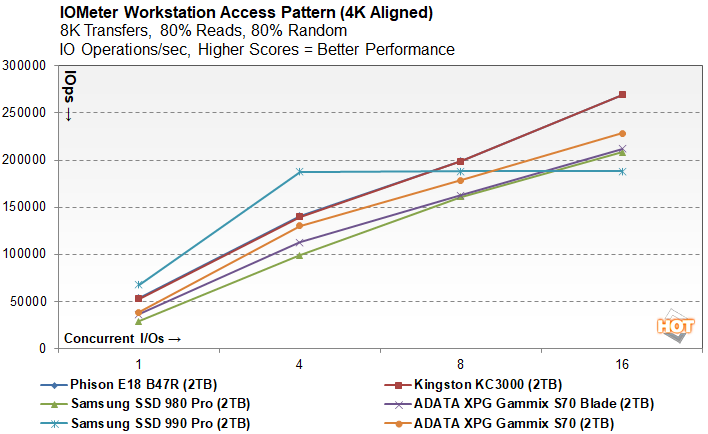
At the lower queue depths, the Samsung SSD 990 Pro led the pack, but performance plateaued beyond QD4 and the other drives pulled ahead at the higher queue depths. Note that for consumer workloads, the lowest queue depths are most important, so the 990 Pro is in good shape here.


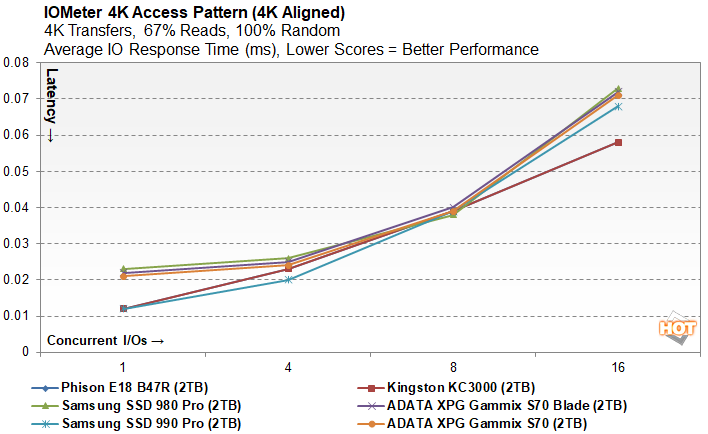
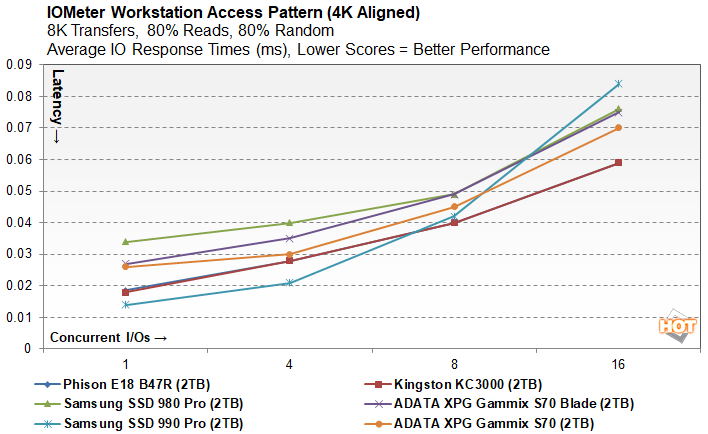
Our latency results also show the Samsung SSD 990 Pro offering some of the lowest (best) latency at the lower queue depths. It's only at the highest queue depth (QD16) that the 990 Pro's latency trails the other drives.
SiSoft SANDRA 2021
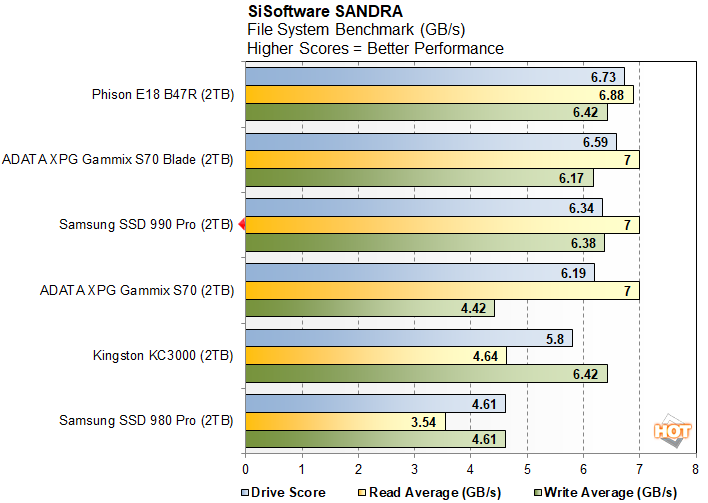
The SANDRA file system benchmark has the top three drives offering similar read averages, with the Samsung 990 Pro landing right in between the Phison and Innogrit-based drives in terms its write average. Once again the 990 Pro clearly outruns Samsung's previous flagship 980 Pro across the board.
ATTO Disk Benchmark
ATTO is another "quick and dirty" type of disk benchmark that measures transfer speeds across a specific volume length. It measures raw transfer rates for both reads and writes and graphs them out in an easily interpreted chart. We chose .5KB through 64MB transfer sizes and a queue depth of 6 over a total max volume length of 256MB. ATTO's workloads are sequential in nature and measure raw bandwidth, rather than I/O response time, access latency, etc.


Save for a dip with 64MB - 256MB block sixes in the write test, the Samsung SSD 990 Pro hangs with the fastest drives we tested according to ATTO.
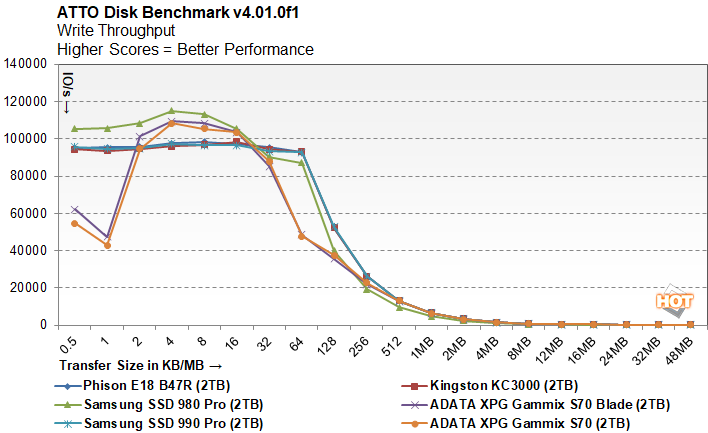
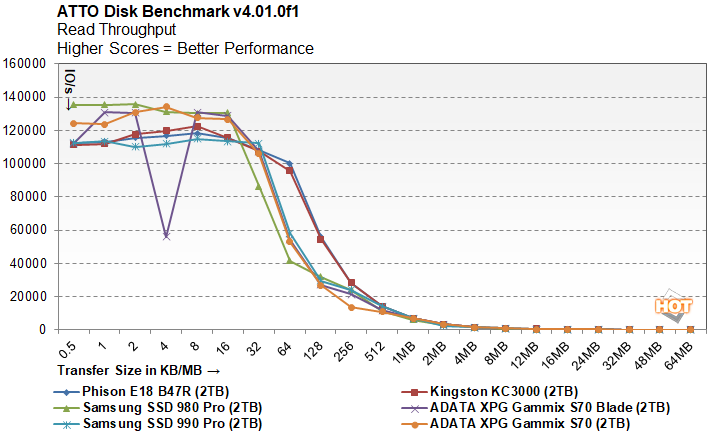
IO performance according to ATTO had the Samsung SSD 990 Pro right in the mix with all of the other drives, though it does trail slightly in the read tests with the smallest transfer sizes.
AS SSD Compression Benchmark
Next up we ran the Compression Benchmark built-into AS SSD, an SSD specific benchmark being developed by Alex Intelligent Software. This test is interesting because it uses a mix of compressible and non-compressible data and outputs both Read and Write throughput of the drive. We only graphed a small fraction of the data (1% compressible, 50% compressible, and 100% compressible), but the trend is representative of the benchmark’s complete results.

